英语倒装句超详细
- 格式:ppt
- 大小:1.53 MB
- 文档页数:129
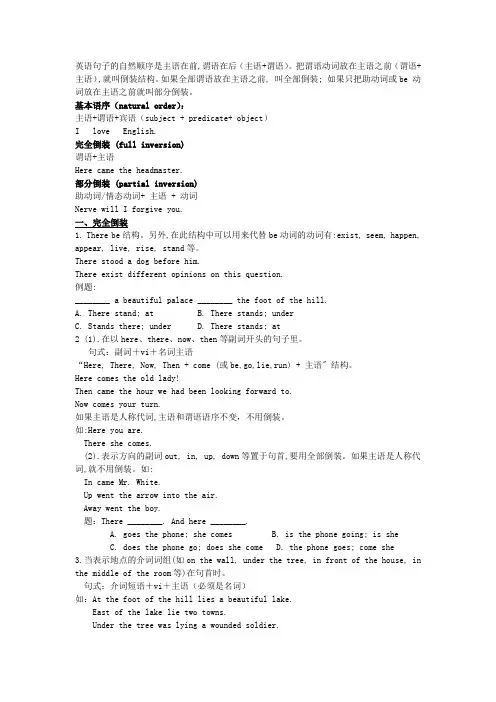
英语句子的自然顺序是主语在前,谓语在后(主语+谓语)。
把谓语动词放在主语之前(谓语+主语),就叫倒装结构。
如果全部谓语放在主语之前, 叫全部倒装; 如果只把助动词或be 动词放在主语之前就叫部分倒装。
基本语序(natural order):主语+谓语+宾语(subject + predicate+ object)I love English.完全倒装 (full inversion)谓语+主语Here came the headmaster.部分倒装 (partial inversion)助动词/情态动词+ 主语 + 动词Nerve will I forgive you.一、完全倒装1. There be结构。
另外,在此结构中可以用来代替be动词的动词有:exist, seem, happen, appear, live, rise, stand等。
There stood a dog before him.There exist different opinions on this question.例题:________ a beautiful palace ________ the foot of the hill.A. There stand; atB. There stands; underC. Stands there; underD. There stands; at2 (1).在以here、there、now、then等副词开头的句子里。
句式:副词+vi+名词主语“Here, There, Now, Then + come (或be,go,lie,run) + 主语" 结构。
Here comes the old lady!Then came the hour we had been looking forward to.Now comes your turn.如果主语是人称代词,主语和谓语语序不变,不用倒装。
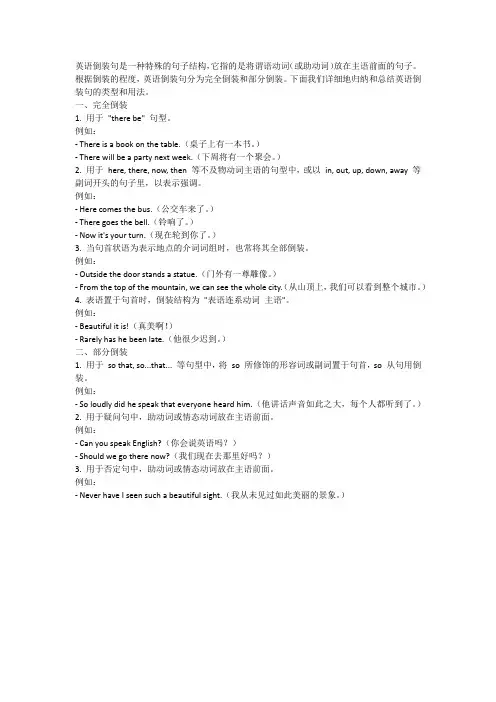
英语倒装句是一种特殊的句子结构,它指的是将谓语动词(或助动词)放在主语前面的句子。
根据倒装的程度,英语倒装句分为完全倒装和部分倒装。
下面我们详细地归纳和总结英语倒装句的类型和用法。
一、完全倒装1. 用于"there be" 句型。
例如:- There is a book on the table.(桌子上有一本书。
)- There will be a party next week.(下周将有一个聚会。
)2. 用于here, there, now, then 等不及物动词主语的句型中,或以in, out, up, down, away 等副词开头的句子里,以表示强调。
例如:- Here comes the bus.(公交车来了。
)- There goes the bell.(铃响了。
)- Now it's your turn.(现在轮到你了。
)3. 当句首状语为表示地点的介词词组时,也常将其全部倒装。
例如:- Outside the door stands a statue.(门外有一尊雕像。
)- From the top of the mountain, we can see the whole city.(从山顶上,我们可以看到整个城市。
)4. 表语置于句首时,倒装结构为"表语连系动词主语"。
例如:- Beautiful it is!(真美啊!)- Rarely has he been late.(他很少迟到。
)二、部分倒装1. 用于so that, so...that... 等句型中,将so 所修饰的形容词或副词置于句首,so 从句用倒装。
例如:- So loudly did he speak that everyone heard him.(他讲话声音如此之大,每个人都听到了。
)2. 用于疑问句中,助动词或情态动词放在主语前面。
例如:- Can you speak English?(你会说英语吗?)- Should we go there now?(我们现在去那里好吗?)3. 用于否定句中,助动词或情态动词放在主语前面。
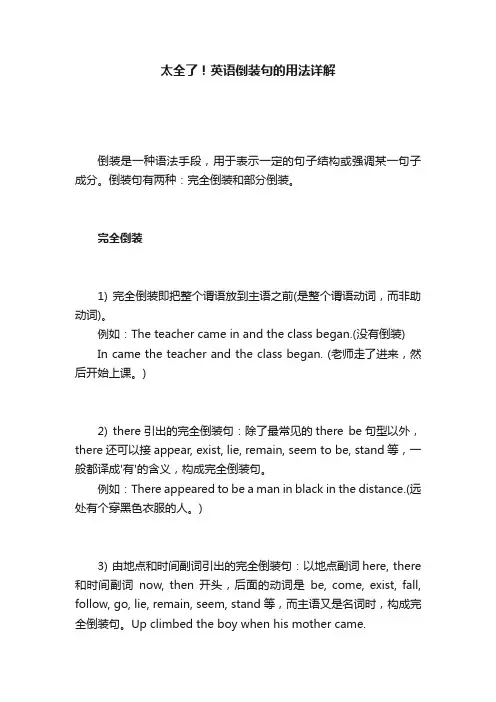
太全了!英语倒装句的用法详解倒装是一种语法手段,用于表示一定的句子结构或强调某一句子成分。
倒装句有两种:完全倒装和部分倒装。
完全倒装1) 完全倒装即把整个谓语放到主语之前(是整个谓语动词,而非助动词)。
例如:The teacher came in and the class began.(没有倒装)In came the teacher and the class began. (老师走了进来,然后开始上课。
)2) there引出的完全倒装句:除了最常见的there be句型以外,there还可以接appear, exist, lie, remain, seem to be, stand等,一般都译成'有'的含义,构成完全倒装句。
例如:There appeared to be a man in black in the distance.(远处有个穿黑色衣服的人。
)3) 由地点和时间副词引出的完全倒装句:以地点副词here, there 和时间副词now, then 开头,后面的动词是be, come, exist, fall, follow, go, lie, remain, seem, stand等,而主语又是名词时,构成完全倒装句。
Up climbed the boy when his mother came.4)表示运动方向的副词或地点状语置于句首,谓语表示运动的动词且主语是名词时使用完全倒装5)在强调状语时(1)当句首状语为方位词或拟声词,谓语动词为go, come等表示位置转移的动词时句子须倒装。
例如:1 Up went the plane.2 In came the chairman and the meeting began.注:如果主语是代词则不发生倒装。
例如:1 Out they rushed!2 Lower and lower he bent.(2) 当句首状语为表示地点的介词词组时,句子须倒装。
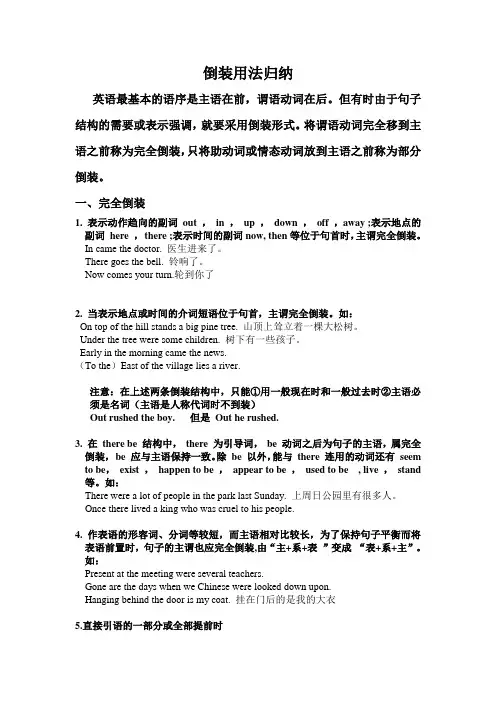
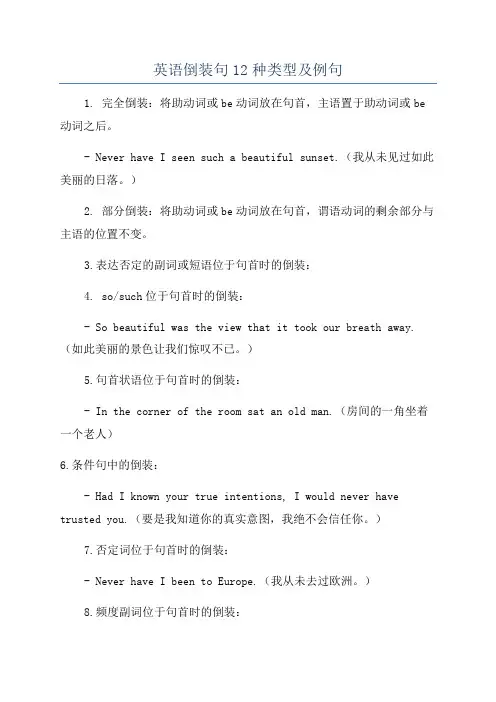
英语倒装句12种类型及例句1. 完全倒装:将助动词或be动词放在句首,主语置于助动词或be 动词之后。
- Never have I seen such a beautiful sunset.(我从未见过如此美丽的日落。
)2. 部分倒装:将助动词或be动词放在句首,谓语动词的剩余部分与主语的位置不变。
3.表达否定的副词或短语位于句首时的倒装:4. so/such位于句首时的倒装:- So beautiful was the view that it took our breath away.(如此美丽的景色让我们惊叹不已。
)5.句首状语位于句首时的倒装:- In the corner of the room sat an old man.(房间的一角坐着一个老人)6.条件句中的倒装:- Had I known your true intentions, I would never have trusted you.(要是我知道你的真实意图,我绝不会信任你。
)7.否定词位于句首时的倒装:- Never have I been to Europe.(我从未去过欧洲。
)8.频度副词位于句首时的倒装:- Rarely do we see such dedication.(我们很少见到如此的奉献精神。
)9.祈使句或祈使句部分的倒装:- Stand up!(站起来!)- Be quiet, please.(请安静。
)10. only位于句首时的倒装:- Only by working hard can you achieve your goals.(只有通过努力工作,你才能实现目标。
)11.地点状语置于句首时的倒装:- In the garden were beautiful flowers.(花园里有美丽的花朵。
)12.宾语置于句首时的倒装:- A love like this I have never felt before.(我之前从未感受过如此的爱。
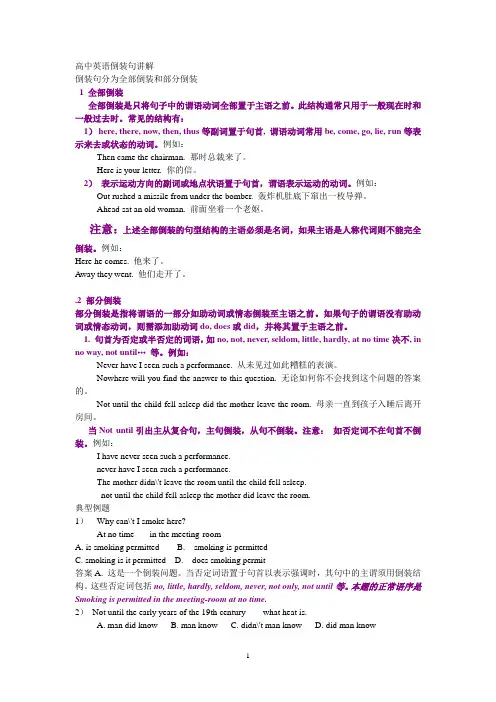
高中英语倒装句讲解倒装句分为全部倒装和部分倒装1 全部倒装全部倒装是只将句子中的谓语动词全部置于主语之前。
此结构通常只用于一般现在时和一般过去时。
常见的结构有:1)here, there, now, then, thus等副词置于句首, 谓语动词常用be, come, go, lie, run等表示来去或状态的动词。
例如:Then came the chairman. 那时总裁来了。
Here is your letter. 你的信。
2)表示运动方向的副词或地点状语置于句首,谓语表示运动的动词。
例如:Out rushed a missile from under the bomber. 轰炸机肚底下窜出一枚导弹。
Ahead sat an old woman. 前面坐着一个老妪。
注意:上述全部倒装的句型结构的主语必须是名词,如果主语是人称代词则不能完全倒装。
例如:Here he comes. 他来了。
Away they went. 他们走开了。
.2 部分倒装部分倒装是指将谓语的一部分如助动词或情态倒装至主语之前。
如果句子的谓语没有助动词或情态动词,则需添加助动词do, does或did,并将其置于主语之前。
1. 句首为否定或半否定的词语,如no, not, never, seldom, little, hardly, at no time决不, in no way, not until…等。
例如:Never have I seen such a performance. 从未见过如此糟糕的表演。
Nowhere will you find the answer to this question. 无论如何你不会找到这个问题的答案的。
Not until the child fell asleep did the mother leave the room. 母亲一直到孩子入睡后离开房间。
当Not until引出主从复合句,主句倒装,从句不倒装。
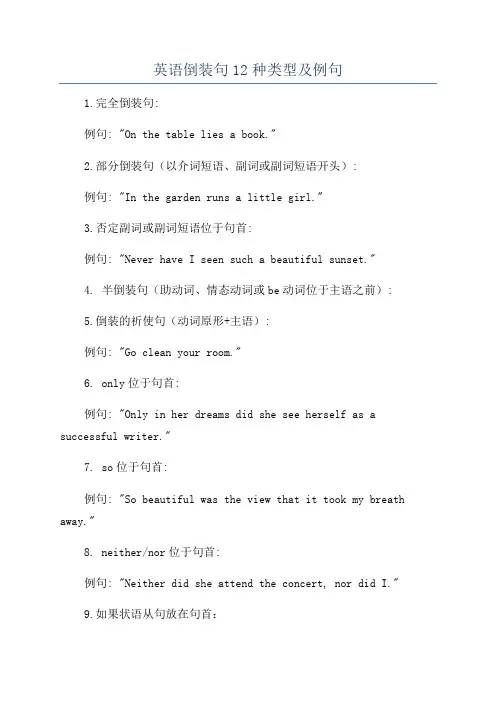
英语倒装句12种类型及例句1.完全倒装句:例句: "On the table lies a book."2.部分倒装句(以介词短语、副词或副词短语开头):例句: "In the garden runs a little girl."3.否定副词或副词短语位于句首:例句: "Never have I seen such a beautiful sunset."4. 半倒装句(助动词、情态动词或be动词位于主语之前):5.倒装的祈使句(动词原形+主语):例句: "Go clean your room."6. only位于句首:例句: "Only in her dreams did she see herself as a successful writer."7. so位于句首:例句: "So beautiful was the view that it took my breath away."8. neither/nor位于句首:例句: "Neither did she attend the concert, nor did I."9.如果状语从句放在句首:10.条件从句位于句首:例句: "Should he fail the exam, he will have to retake the course."11.介词短语或副词短语位于句首:例句: "In the corner sat a small dog."12. or/ nor引导的短语或句子位于句首:。
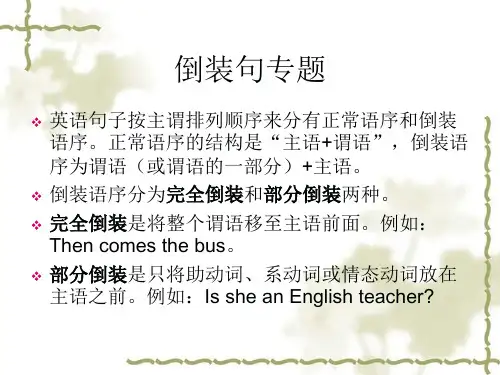
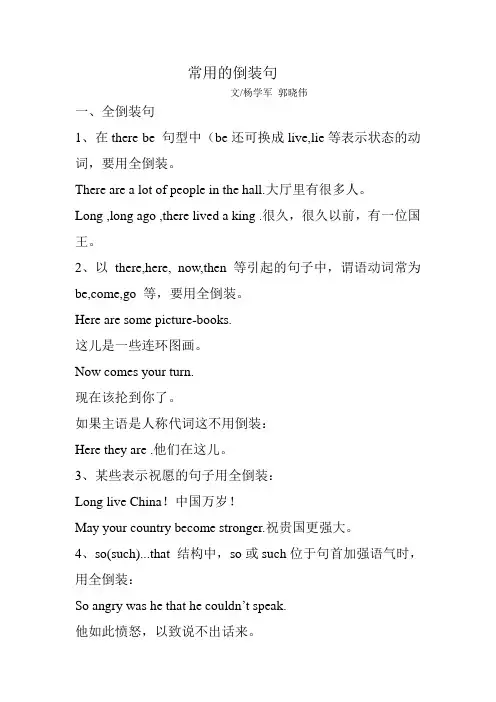
常用的倒装句文/杨学军郭晓伟一、全倒装句1、在there be 句型中(be还可换成live,lie等表示状态的动词,要用全倒装。
There are a lot of people in the hall.大厅里有很多人。
Long ,long ago ,there lived a king .很久,很久以前,有一位国王。
2、以there,here, now,then 等引起的句子中,谓语动词常为be,come,go 等,要用全倒装。
Here are some picture-books.这儿是一些连环图画。
Now comes your turn.现在该抡到你了。
如果主语是人称代词这不用倒装:Here they are .他们在这儿。
3、某些表示祝愿的句子用全倒装:Long live China!中国万岁!May your country become stronger.祝贵国更强大。
4、so(such)...that 结构中,so或such位于句首加强语气时,用全倒装:So angry was he that he couldn’t speak.他如此愤怒,以致说不出话来。
5、在in,out,aways,off,up,down 等副词开头的句中,为了使情景更生动,用全倒装:Up went the arrow into the air.嗖地一声,箭射上了天。
注:主语是代词时,则不用倒装:Away they went.他们走了。
6、整个(或部分)直接引语置于名词充当的主语前时,用全倒装:“They must be in the fields now.”thought Mr Li.“他们准是下地了,“李先生想。
注:主语是人称代词时,多不用倒装:“What do you want?”he asked.“你要什么?”他问。
7、为保持句子平衡,或使上下文衔接更紧,可把介词短语、形容词、副词或分词提到句首,引起全倒装:On the ground lay an old sick goat,which had gone into the cave to die.地上躺着一只有病的老山羊,它是到洞里去等死的。
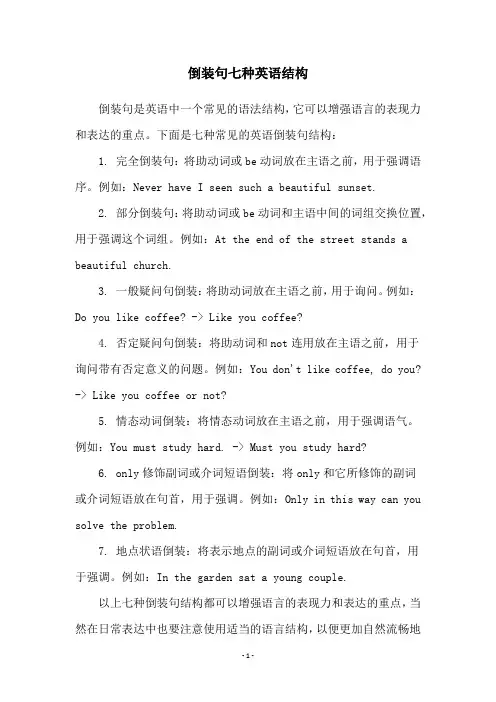
倒装句七种英语结构倒装句是英语中一个常见的语法结构,它可以增强语言的表现力和表达的重点。
下面是七种常见的英语倒装句结构:1. 完全倒装句:将助动词或be动词放在主语之前,用于强调语序。
例如:Never have I seen such a beautiful sunset.2. 部分倒装句:将助动词或be动词和主语中间的词组交换位置,用于强调这个词组。
例如:At the end of the street stands a beautiful church.3. 一般疑问句倒装:将助动词放在主语之前,用于询问。
例如:Do you like coffee? -> Like you coffee?4. 否定疑问句倒装:将助动词和not连用放在主语之前,用于询问带有否定意义的问题。
例如:You don't like coffee, do you? -> Like you coffee or not?5. 情态动词倒装:将情态动词放在主语之前,用于强调语气。
例如:You must study hard. -> Must you study hard?6. only修饰副词或介词短语倒装:将only和它所修饰的副词或介词短语放在句首,用于强调。
例如:Only in this way can you solve the problem.7. 地点状语倒装:将表示地点的副词或介词短语放在句首,用于强调。
例如:In the garden sat a young couple.以上七种倒装句结构都可以增强语言的表现力和表达的重点,当然在日常表达中也要注意使用适当的语言结构,以便更加自然流畅地表达意思。
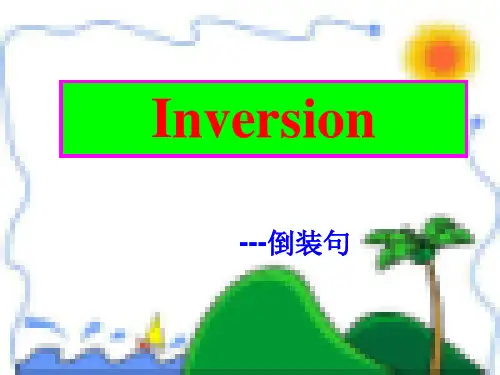
高中英语语法——倒装句一、定义:英语的基本句型是主语+ 谓语。
如果将主语与谓语调换, 称倒装句。
二、分类:(完)全倒装句半倒装句(部分倒装)三、运用(一)完全倒装: 主语与谓语交换位置不需任何助动词, 叫完全倒装。
有以下三种情况:1. 当here, there, out, in, up, down等副词放在句首时, 句子需全倒装:There goes the bell! 铃响了!There lived an old man.Here comes the bus.注意:①在这种情况下倒装仅限于不及物动词或be动词, 像go, come, rush等。
②主语如果是代词时不需倒装如Away he went. 他走远了。
2. 方位状语在句首如: In front of the house stopped a police car.Nearby were two canoes in which they had come to the island.Under the tree sat a boy.如:"What does it mean?" asked the boy或the boy asked.(二)半倒装: 主语与谓语的助动词交换位置称半倒装,有以下数种情况:1. 否定意义的词在句首, 句子半倒装【little, never, not, no, hardly, rarely, seldom】例:Never shall I forget you.At no time and in no circumstances will China be the first to use nuclear weapons.在任何时候任何情况下中国都不会首先使用核武器。
Little did I understand what he said to me at that time.2. 几对并列连词not only…but also, hardly… when等连接两个并列句, 连词在Not only was everything he had taken away from him, but also his German citizenship was taken away.No sooner had I got to the bus stop than the bus started.注意:①not only…but also连接两个并列主语时不需倒装如: Not only you but also I like playing chess.②neither…nor在句首时, 前后两句都需倒装如:Neither do I have a sister nor does my husband.3. only在句首强调状语,主句半倒装:如:Only then did I realize that I was wrong.Only in this way can I learn from my fault.Only when the war was over in 1918, was he able to get back to work.注意: only强调主语不倒装:Only the teachers can use the room.4. so…that句型, so在句首时, 主句倒装, that从句不倒装:如:So easy is it that a child can learn it.So hard did he work that he finally won the fame.I saw the film, so did he.5.省略了if的虚拟条件句如:Had I been informed earlier, I could have done something.Were she here, she would support the motion.【典型例题】1. _____can you expect to get a pay rise.A. With hard workB. Although work hardC. Only with hard workD. Now that he works hard2. Seldom ____ any mistakes during my past few years of working here.A. would I makeB. did I makeC. I did makeD. shall I make3. Not until all the fish died in the river, _____ how serious the pollution was.A. did the villagers realizeB. the villagers realizedC. the villagers did realizeD. didn’t the villagers realize4. Not until I began to work ____ how much time I had wasted.A. didn’t realizeB. did I realizeC. I didn’t realizeD. I realized5.—Do you know Jim quarrel with his brother?—I don’t know, _______.A. nor don’t I careB. nor do I careC. I don’t care neitherD. I don’t care also6. Only by practicing a few hours every day _____ be able to waste much time.A. you canB. can youC. you willD. will you7. Not until the early years of the19th century ___ what heat is.A. man did knowB. man knewC. didn’t man knowD. did man know8. _____got into the room, _____ the telephone rang.A. He hardly; thenB. Hardly had he; whenC. He had not; thanD. Not had he; when9. Only in this way ______ do it well.A. must weB. we couldC. can weD. we can10.—I don’t think I can walk any further.—_____, Let’s stop here for a rest.A. Neither can IB. Neither do IC. I didn’t think soD. I think so答案:CBABB DDBBB【课后巩固】1.His mother had talked to him for many minutes while he was watching TV, but _.A. a little did he hearB. little did he hearC. little heard heD. a little heard heB2 _____the plane.A. Flew downB. Down flewC. Down was flyingD. Down flyB3. During the war, ____but also he lost his wife and his child.A. not was his job in the lab taken awayB. not only was his job in the lab taken awayC. not merely his job in the lab was taken awayD. not just was taken away his job in the labB2. What sport do you like best?—— Springboard diving (跳板跳水).——____to dive into water from high board!A. What a fun is itB. How fun it isC. How a fun is itD. What fun it isD5. I think this is the first time that we have met.___anywhere.A. Before have we never seen each otherB. Never before we have seen each otherC. Each other have we seen never beforeD. Never before have we seen each otherD6.—— We have to stop talking here outside. Listen,_____!—— Hurry up, or we’ll be late.A. There goes the bellB. There does the bell goC. There the bell goesD. Goes the bell thereA7. ______ snacks and drinks,but they also brought cards for entertainment when they had a picnic in the forest.A. Not only they broughtB. Not only did they bringC. Not only brought theyD. Not only they did bringB8. She didn’t come to the party last Sunday.___, she must have made the party more exciting.A. If she cameB. Would she comeC. Had she comeD. Did she comeC9. Hardly ____ when it began to rain.A. had he arrivedB. arrived heC. he had arrivedD. did he arriveC10. I received his mother’s telephone call at eleven.__that he was badly hurt in an accident yesterday.A. Then did I knowB. Only then I knewC. Only then did I knowD. Only then knew IC11. There ____ .A. come theyB. they comeC. they are comeD. they will comeB12. ______, I would have given you his address.A. If you asked meB. You had asked meC. Should you have asked meD. Had you asked meD13. Only when you have finished your homework ___ go home.A. can youB. would youC. you willD. you canA14. Many a time _____ me good advice.A. he gaveB. does he giveC. he has givenD. has he givenD15. Hardly _____ when the bus suddenly pulled away.A. they had got to the bus stopB. they got to the bus stopC. did they get to the bus stopD. had they got to the bus stopD16. ____ have I seen a better performance.A. EverywhereB. somewhereC. Everywhere elseD. NowhereD17. Only when class began ___ that he had left his book at home.A. will he realizeB. he did realizeC. did he realizeD. should he realizeC18. Only in an hour ago ____ out why he was absent.A. did the teacher foundB. the teacher foundC. did the teacher findD. had the teacher foundC19. Not a single word ____ at the beginning.A. did he sayB. has he saidC. he saidD. he has said A20. ______ that I couldn’t be absorbed in the work.A. They made such talkedB. So loudly they talkedC. It was noise outsideD. Such a loud noise did they make D21. ______ that he could not speak for a long time.A. So frightened was heB. So frightened he wasC. Was he so frightenedD. Frightened was heA22. Not only ______ a promise, but he also kept it.A. had he madeB. he had madeC. did he makeD. he makesC23. ______ I had time, I would have run round that lake again.A. IfB. UnlessC. HadD. WhenC。
倒装句详解概念:用以表示一定句子结构的需要和强调某一句子成分的需要,分为完全倒装和部分倒装。
一.完全倒装:句子中的谓语动词全部置于主语之前.此结构通常只用与一般现在时和一般过去时。
1.以here, there, now, then等副词或 out, in, up, down, away等表示运动方向的副词或地点状语置于句首以示强调,句子要全部倒装, 谓语动词常用come,go, be, lie,run,rush等.2. 表示地点的介词短语位于句首时A beautiful lake lies at the foot of the hillAt the foot of the hill lies a beautiful lake。
注意:在上述句子中, 如果主语为人称代词, 则主、谓不需要倒装。
In he came and back he went again.Away he went .二.部分倒装:be/助动词/情态动词提前到主语的前面.Is am are was were(be动词)do does did(助动词) can could would may will might(情态动词)等1。
only所修饰的副词、介词短语或状语从句放在句首时,要进行部分倒装.Only then did I realize the importance of learning English.Only after he came back was I able to see him。
注:only修饰主语,仍用自然语序,如:Only socialism can save China.I seldom go to the cinema。
倒装:Seldom do I go to the cinema.我很少去看电影.I have never seen such a performance。
倒装:Never have I seen such a performance。
英语倒装句用法经典总结英语部分倒装用法归纳1. 否定副词位于句首时的倒装在正式文体中,never, seldom, rarely, little, hardly, scarcely, no sooner, no longer, nowhere 等含有否定意义的副词若位于句首,则其后要用部分倒装:I shall never forgive him. / Never shall I forgive him. 我永远不会宽恕他。
He seldom goes out for dinner. / Seldom does he go out for dinner. 他很少出去吃饭。
She hardly has time to listen to music. / Hardly does she have time to listen to music. 她几乎没时间听音乐。
He little realizes how important this meeting is. / Little does he realize how important this meeting is. 他不甚明白这个会议的重要性。
We had no sooner reached the airport than the plane took off. / No sooner had we reached the airport than the plane took off. 我们刚到机场,飞机就起飞了。
【注意】(1) 对于not…until句型,当not until…位于句首时,其后的主句要用倒装语序:He didn’t leave the room until the rain stopped. / Not until the rain stopped did he leave the room. 雨停了之后他才离开这房间。
语法精讲:英语倒装句总结倒装的种类英语最基本的词序是主语在谓语动词的前面。
如果将句子的主语和谓语完全颠倒过来,这称之为完全倒装。
如果只将助动词或情态动词移至主语之前,谓语的其他部分仍保留在主语的后面,这称之为部分倒装。
一.完全倒装完全倒装是将谓语的全部放在主语之前,此结构通常只用于一般现在时和一般过去时两种。
On her left sat her husband.她左边坐着她丈夫。
Here is the book you want.你要的书在这儿。
Down went the small boat.小船沉下去了。
二.部分倒装部分倒装是指将谓语的一部分,如助动词或情态动词,移至主语之前。
Only by working hard can one succeed.只有努力才能成功。
Never have I seen her before.我以前没见过她。
提示:如果句中的谓语没有助动词或情态动词,则需添加助动词do,does或did,并将其置于主语之前。
Well do I remember the day I joined the League.入团的那一天,我记忆犹新。
Little did I think that he could be back alive.我没有想到他竟能活着回来。
三.常见的倒装结构A.常见的完全倒装结构1.there be句型。
There is a mobile phone and some books on the desk.桌上有一个手机和一些书。
There are thousands of people gathering on the square.广场上聚集着成千上万的人。
注意:引导词there还可以接appear,exist,lie,remain,seem,stand,live等词。
There lived an old fisherman in the village.村里住着一位老渔夫。
英语倒装句的归纳总结《英语倒装句》倒装句是英语中常见的语法结构,它通过将谓语动词或助动词放在主语之前,以改变句子的语序。
倒装句在不同语境下有不同的应用,它可以使句子更加强调,或者用于疑问句、条件句等特殊情况。
下面对英语倒装句进行归纳总结。
一、全部倒装1. 在以否定词开头的句子中,把助动词或情态动词提到主语之前。
- Not only did he pass the exam, but he also got the highest score.(不仅他通过了考试,而且他还得了最高分。
)- Never have I seen such a beautiful sunset.(我从未见过如此美丽的日落。
)2. 在表示方向的介词短语之前,把助动词或情态动词提到主语之前。
- Up went the balloon into the sky.(气球升上了天空。
)- Out rushed the children when the school bell rang.(学校铃声一响,孩子们冲了出去。
)二、部分倒装1. 在以否定副词或副词短语开头的句子中,把助动词或情态动词提到主语之前。
- Hardly had I entered the room when the phone rang.(我一进屋就电话响了。
)- Nor did he mention anything about the incident during the meeting.(在会议期间,他也没有提到这个事件。
)2. 在表示条件的状语从句中,把助动词或情态动词提到主语之前。
- Should you need any assistance, please do not hesitate to contact us.(如果你需要任何帮助,请随时与我们联系。
)- Were he to find out the truth, he would be devastated.(如果他发现真相,他会崩溃的。
英语倒装句的四种基本句型例句嗨,小伙伴们!今天咱们来好好唠唠英语倒装句的四种基本句型,这可真是英语学习里超有趣的一部分呢。
就像一场奇妙的语言魔术,让句子变得超级有特色。
**一、完全倒装(Full Inversion)**完全倒装就是把整个谓语动词都放到主语之前啦。
这就好比是把一场演出的主角(主语)和配角(谓语)的出场顺序完全颠倒了一下,给人一种很新奇的感觉。
例句1:There goes the bell.(铃响了。
)你看,正常的语序应该是The bell goes there. 但是这样一倒装,就有一种突然性,就像你正等着什么事情发生,然后“铃就响了”,这种表达更加生动。
我还记得我刚学这个的时候,我同学问我:“为啥要这么说呀?直接说The bell goes there不就得了?”我就跟他说:“哎呀,这就像你去看魔术表演,魔术师要是按平常的方式出牌,那还有啥惊喜呢?这种倒装句就像魔术里的大变活人,突然把主语和谓语的位置变了,让句子变得超酷。
”例句2:Here comes the bus.(公共汽车来了。
)想象一下,你在车站等车等得心急火燎的,然后你大喊一声“Here comes the bus”,是不是感觉比“The bus comes here”更带感呢?这时候句子就像是一个充满活力的小助手,快速地把重要的信息“bus来了”传达给你。
例句3:Away flew the birds.(鸟儿飞走了。
)这个句子要是正常说就是The birds flew away. 可一旦倒装,就像是我们在描述一个很突然的画面,鸟儿“嗖”的一下就飞走了,那种动态感更强了。
我跟我的英语老师讨论这个句子的时候,老师说:“你看,这种倒装就像是给句子加了个加速器,让动作更迅速地呈现在读者或者听者的脑海里。
”我当时就觉得,哇塞,真的是这样呢!**二、部分倒装(Partial Inversion)**部分倒装呢,就是只把助动词、情态动词或者be动词放到主语前面,主要动词还在主语后面呢。